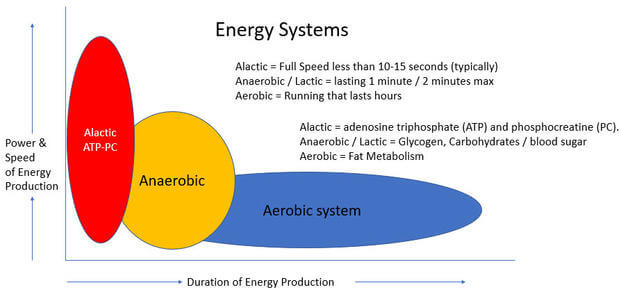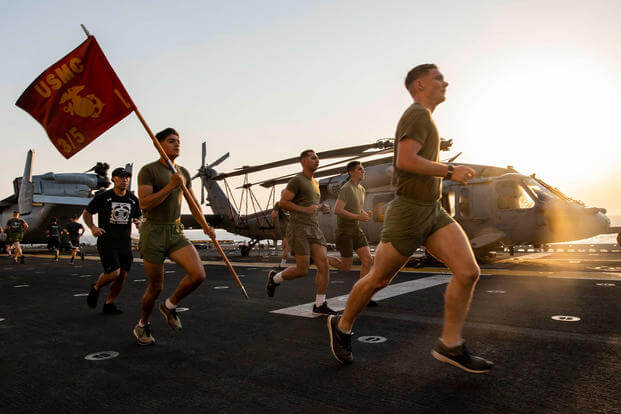Questions on running often come from fitness enthusiasts looking to burn calories, novice runners doing their first race, military members for timed runs and young sprinters seeking to get faster for team sports.
There are so many ways to run. Running faster for timed runs, running for longer distances, adding agility for sports and adding weight for military rucking events are just some of the most popular.
Below is a list of strategies to improve and information to learn what is required physiologically for each of the different styles and energy systems of running.
The energy used when running
For athletes in certain competitive sports, the energy systems apply specifically to them -- but for those involved in the tactical professions, that include tactical fitness and PT tests and long days of grueling work. A mix of all will be required.

Sprinting or lifting heavy weights: This is considered anaerobic training. Full-out 100% sprinting requires a lot of energy quickly, and your body only can handle a few seconds of this type of running. You may have heard a coach yell, "Pace yourself; don't start off too fast."
There is a reason for that. You burn out quickly, using the high-octane fuel of ATP-PC (adenosine triphosphate/phosphocreatine). To maintain your energy levels during sprint workouts, you should have a solid balance of protein and carbs, and these nutrients will be used to help your body make more ATP-PC quickly. Staying hydrated is also key.
About 3-4 hours before the race, eating foods sampled below is recommended:
- Greek yogurt, lean meat proteins (poultry, beef, fish), beans, potatoes, brown rice.
- To help with recovery and synthesis of more ATP-PC, add in carb drinks, fruit and vegetables, too.
Running fast (anaerobic): Once you no longer can sprint full speed (run out of ATP-PC), you will downshift into the energy system and start to use the glycogen stored in the muscles and liver as well as the blood sugar in the bloodstream. Adding some carbohydrates before training, competitions or testing is a good way to use that fuel source.
Often prior to downshifting into the aerobic zone below, you will go from anaerobic until you can no longer (depending on your race/run strategy). When running timed runs, many like the goal pace strategy and try to run faster the last few laps of the run's distance. This will help you not burn out too fast and save some fuel for pushing the last 15%-20% of the run. Up to two hours before exercise, testing or competition, eat fruits, vegetables, honey, whole grains or low-fat foods with higher sugar/complex carbohydrate content.
Running slow and steady: Your body will use glycogen and ATP-PC primarily during initial movement. However, at a lower heart rate, your body can keep up with the oxygen demands, and the fuel source from fat metabolism can get to work. Therefore, you can go for hours.
However, you still need to hydrate with electrolytes and eat a balanced diet of carbs, protein and fats when most of your exercise will be in this zone. Your training level and conditioning also determine what energy system is being used.
If an average person tries to run a five-minute mile, they likely will be in the anaerobic zone, burning blood sugar and glycogen. However, if a trained high-level marathoner runs a five-minute mile, their heart rate may place them in the aerobic zone so their energy needs will be different. It depends on your conditioning as to what energy system is used and how you perform.
Relative fitness strategies
Fitness is relative. Someone's warmup could be another's full workout. Someone's five-minute mile run could be someone's easy jog and another's full sprint. Therefore, the energy systems we use are also relative to our abilities and conditioning. Depending upon your fitness level and goals, your training and testing procedures will require different fueling and testing and competing strategies.
For instance, if passing a fitness test is an easy day for you, a rest day before the test and carb loading before the event is not necessary. However, if you are at borderline failure or striving to max it for the first time ever, you can benefit from a day taper and the additional fuel source of carb loading before the test, as well as sipping a carbohydrate drink during the test (between sets). The high-rep calisthenics, running fast (and swimming, depending on the test) will put you in an anaerobic state, burning carbs and glycogen for 30-45 minutes. That will require some additional carbs both before and during the test for most people.
For longer distance events (long platoon runs or rucks), you still will need to have plenty of glycogen stores, but the ability to keep a lower heart rate during the event depends on your conditioning. The better conditioned athlete, the more likely you will remain in the aerobic zone and burn up a longer-lasting fuel source -- fat.
Mix in some speed and interval training with your running to push your conditioning and work the anaerobic energy system better, versus just getting good at longer, slower distance running.
Practicing slow running will make you good just at running slowly. But if that is what you need -- more longer distance running and work capacity -- adding a few long runs into the week is also beneficial, especially if you make those rucking miles for the tactical athlete.
See this running plan that mixes in a sprint day (or two) for speed, a goal pace running day to learn the pace you need for timed runs or event pace, and longer or slower distance runs or load-bearing events, depending on what kind of distance rucking you need to ace.
Stew Smith is a former Navy SEAL and fitness author certified as a Strength and Conditioning Specialist (CSCS) with the National Strength and Conditioning Association. Visit his Fitness eBook store if you’re looking to start a workout program to create a healthy lifestyle. Send your fitness questions to stew@stewsmith.com.
Want to Learn More About Military Life?
Whether you're thinking of joining the military, looking for fitness and basic training tips, or keeping up with military life and benefits, Military.com has you covered. Subscribe to Military.com to have military news, updates and resources delivered directly to your inbox.
















